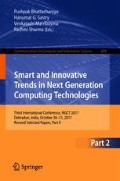Abstract
The public key cryptosystems are mainly used to provide two cryptographic services called confidentiality and authentication. The RSA is one well known and widely used public key cryptosystem that uses two large and distinct integers to generate the keys. In this paper, we proposed an enhanced and secured RSA public key cryptosystem (ESRPKC) algorithm using Chinese remainder theorem. To increase the complexity of the system the proposed ESRPKC uses four prime numbers instead of two primes to generate the public/private key pairs. To generate the public/private key pairs, the proposed ESRPKC uses similar method as that of traditional RSA. In order to enhance the security level, the encryption and decryption functions are modified in proposed ESRPKC. The encryption function uses one extra key parameter called encryption key which is generated by using Chinese remainder theorem. The decryption function also uses one extra parameter to decrypt the message. The complexity of encryption and decryption functions is also acceptable. The proposed algorithm requires only one extra multiplication to perform encryption and decryption operations as compare to traditional RSA cryptosystem. The proposed scheme is highly secured because the encryption and decryption functions uses one extra key parameter and are not only dependent on the public and private key pairs respectively. The security and performance analysis ensures that the proposed ESRPKC algorithm is highly secure and efficient as compare to existing schemes.
Access this chapter
Tax calculation will be finalised at checkout
Purchases are for personal use only
References
Thangavel, M., et al.: An Enhanced and Secured RSA Key Generation Scheme (ESRKGS). J. Inf. Secur. Appl. 20, 3–10 (2015)
Rivest, R.L., Shamir, A., Adleman, L.: A method for obtaining digital signatures and public-key cryptosystems. Commun. ACM 21(2), 120–126 (1978)
Blömer, J., May, A.: A generalized wiener attack on RSA. In: Bao, F., Deng, R., Zhou, J. (eds.) PKC 2004. LNCS, vol. 2947, pp. 1–13. Springer, Heidelberg (2004). https://doi.org/10.1007/978-3-540-24632-9_1
Wiener, M.: Cryptanalysis of short RSA secret exponents. IEEE Trans. Inf. Theory 36(3), 553–558 (1990)
Al-Hamami, A.H., Aldariseh, I.A.: Enhanced method for RSA cryptosystem algorithm. In: International Conference on Advanced Computer Science Applications and Technologies, Kuala Lumpur, pp. 402–408 (2012)
Ali, H., Al-Salami, M.: Timing attack prospect for RSA cryptanalysis using genetic algorithm technique. Int. Arab J. Inf. Technol. 1(1), 80–85 (2004)
Ivy, P.U., Mandiwa, P., Kumar, M.: A modified RSA cryptosystem based on ‘n’ prime numbers. Int. J. Eng. Comput. Sci. 1(2), 63–66 (2012)
Jamgekar, R.S., Joshi, G.S.: File encryption and decryption using secure RSA. Int. J. Emerg. Sci. Eng. (IJESE) 1(4), 11–14 (2013)
Chhabra, A., Mathur, S.: Modified RSA algorithm: a secure approach. In: International Conference on Computational Intelligence and Communication Networks, Gwalior, pp. 545–548 (2011)
Mahajan, S., Easo, S.: Performance evolution of RSA and new cryptosystem. Int. J. Emerg. Technol. Adv. Eng. 2(3), 279–283 (2012)
Minni, R., Sultania, K., Mishra, S., Vincent, D.R.: An algorithm to enhance security in RSA. In: Fourth International Conference on Computing, Communications and Networking Technologies (ICCCNT), Tiruchengode, pp. 1–4 (2013)
Segar, T.C., Vijayaragavan, R.: Pell’s RSA key generation and its security analysis. In: Fourth International Conference on Computing, Communications and Networking Technologies (ICCCNT), Tiruchengode, pp. 1–5 (2013)
Sharma, S., Sharma, P., Dhakar, R.S.: RSA algorithm using modified subset sum cryptosystem. In: International Conference on Computer & Communication Technology (ICCCT), Allahabad, pp. 457–61 (2011)
Wu, C.H., Hong, J.H., Wu, C.W.: RSA cryptosystem design based on the Chinese remainder theorem. In: Design Automation Conference, Proceedings of the ASP-DAC, Yokohama, pp. 391–395 (2001)
Schneier, B.: Applied Cryptography, 2nd edn. Wiley, New Delhi (2012)
Kahate, A.: Cryptography and Network Security, 2nd edn. Tata McGraw-Hill, New Delhi (2005)
Stallings, W.: Cryptography and Network Security, 4th edn. Pentice-Hall of India, New Delhi (2007)
Whitman, M.E., Mattord, H.J.: Principles of Information Security, 5th edn. Cengage Learning, Boston (2015)
Pachghare, V.K.: Cryptography and Information Security, 2nd edn. PHI Learning Private Limited, Delhi (2015)
Forouzan, B.A., Mukhopadhyay, D.: Cryptography and Network Security, 2nd edn. Tata McGraw Hill Education Private Limited, New Delhi (2016)
Author information
Authors and Affiliations
Corresponding author
Editor information
Editors and Affiliations
Rights and permissions
Copyright information
© 2018 Springer Nature Singapore Pte Ltd.
About this paper
Cite this paper
Kumar, V., Kumar, R., Pandey, S.K. (2018). An Enhanced and Secured RSA Public Key Cryptosystem Algorithm Using Chinese Remainder Theorem. In: Bhattacharyya, P., Sastry, H., Marriboyina, V., Sharma, R. (eds) Smart and Innovative Trends in Next Generation Computing Technologies. NGCT 2017. Communications in Computer and Information Science, vol 828. Springer, Singapore. https://doi.org/10.1007/978-981-10-8660-1_42
Download citation
DOI: https://doi.org/10.1007/978-981-10-8660-1_42
Published:
Publisher Name: Springer, Singapore
Print ISBN: 978-981-10-8659-5
Online ISBN: 978-981-10-8660-1
eBook Packages: Computer ScienceComputer Science (R0)

